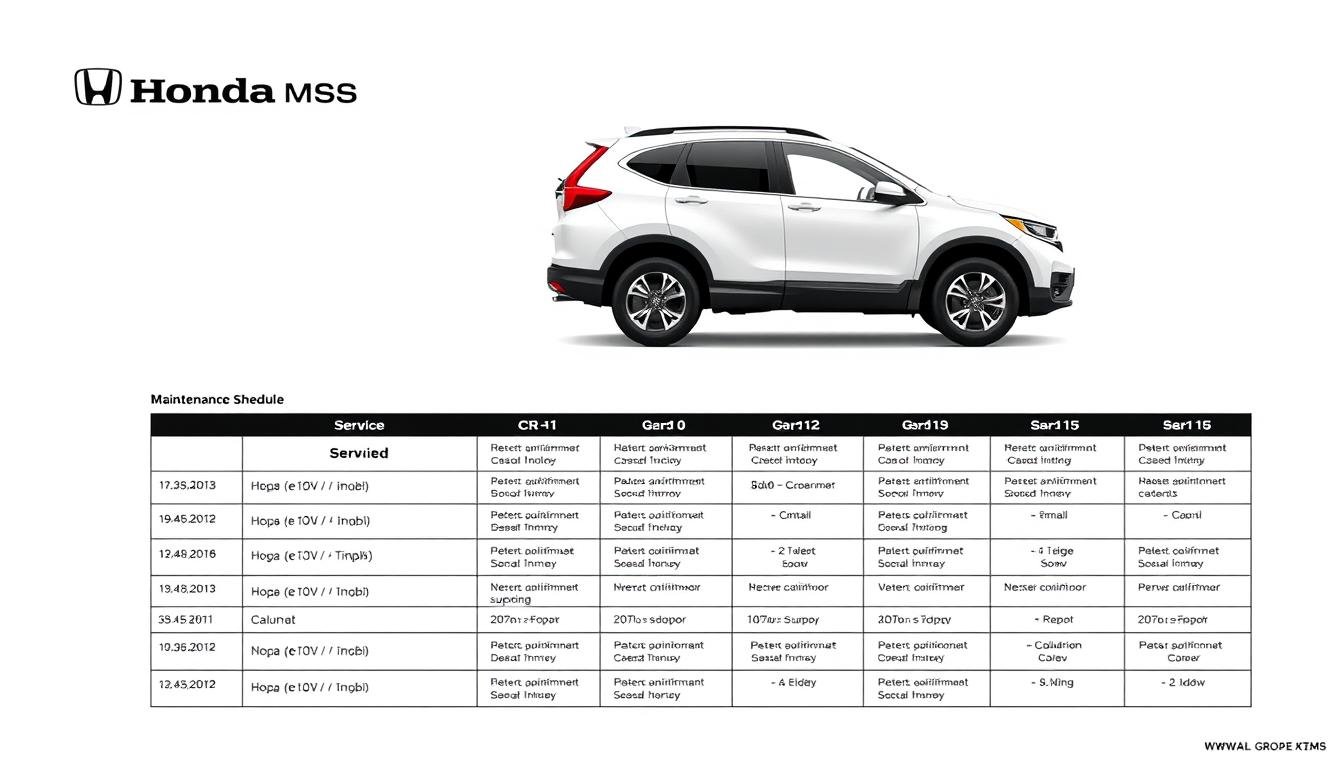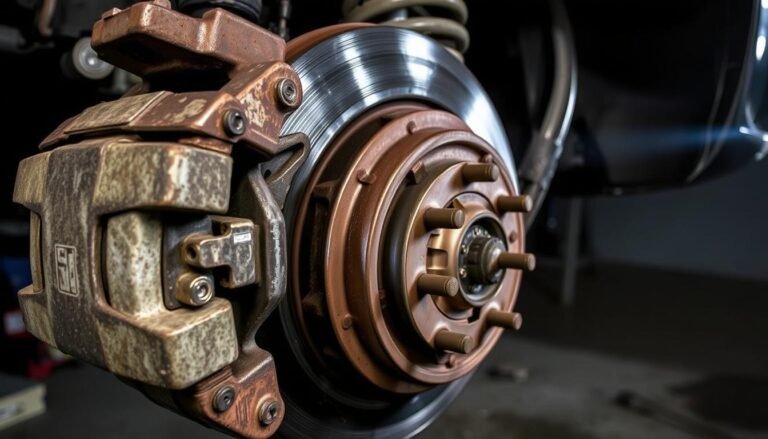Honda CR V Maintenance Schedule Guide
What’s the Honda Cr v maintenance schedule? It’s a plan to keep your car running well, safely, and for a long time.
Doing regular maintenance makes your driving better and avoids big repair bills in the future.
This guide shows you the key parts of the Honda CR-V maintenance list, like when to service it and important tasks you shouldn’t skip.
We’ll show you the best maintenance schedule for the Honda CR-V. This will help you know how to do routine checks right.
You’ll find out what services your car needs at different miles. This gives you a clear plan for taking good care of your car.
From oil changes to keeping tires in good shape, it’s important to know the parts of the schedule to make your car last longer.
Stay with us, and you’ll learn how to follow your Honda CR-V maintenance schedule well. This lets you drive feeling sure and calm.
Let’s get into how to keep your Honda CR-V in top shape, starting with sticking to a regular maintenance plan.
Introduction To Honda CR-V Maintenance
Keeping your Honda CR-V in good shape is key to its long life and strong performance.
This honda cr v routine maintenance guide highlights the important steps to take care of your car. Timely maintenance reduces the risk of breakdowns and makes driving safer.
Sticking to the schedule for honda cr v maintenance boosts your car’s reliability. By following a set plan according to how much you drive and your driving conditions, your Honda CR-V will perform better.
Plus, regular check-ups can save you money by avoiding pricey repairs in the future.
Importance of Following A Maintenance Schedule
Keeping up with your Honda CR-V’s maintenance is key for many reasons. A solid honda cr v scheduled maintenance plan keeps you safe and ensures your car performs well for years.
It’s a big part of owning a car responsibly.
Safety and Performance
Regular check-ups boost both safety and how well your car runs. Doing things like changing oil, checking brakes, and rotating tires can stop breakdowns and accidents.
By sticking to the advised honda cr v service intervals, you can catch and fix problems early. This makes your drive smoother and saves gas.
Longevity of The Vehicle
Staying on top of maintenance helps your Honda CR-V last longer. It keeps your car’s value and stops many unexpected repairs.
With regular care, you can rely on your vehicle’s performance for a long time.
What is The Honda CR-V Maintenance Schedule?
Knowing the Honda CR-V maintenance schedule is key to keeping your vehicle running well. It tells you when to get services based on how many miles your car has.
Following this schedule boosts your car’s performance and makes it last longer. There are important services your Honda CR-V needs at different times.
Knowing these recommended services helps keep your warranty valid and your car safe. It’s smart to know this timeline to avoid expensive repairs later.
How you drive affects how often your car needs servicing. For example, if you often take short trips, tow, or drive in very hot or cold weather, your car will need service more often.
Knowing this helps you make smart choices for your Honda CR-V’s care.
Honda CR-V Service Intervals
Knowing when to service your honda cr v is key to keeping it running well. Regular check-ups keep it performing smoothly and help avoid big problems later.
Below, we highlight important mileage marks for service, what they include, and give you the knowledge you need for your next service visit.
Key Mileage Intervals To Note
It’s important to stick to a honda cr v maintenance schedule at certain mileages. Here’s a table showing important service points and what each one recommends:
| Mileage Interval | Service Recommendations |
|---|---|
| 7,500 Miles | Oil change, tire rotation, fluid level checks, brake inspection |
| 15,000 Miles | Oil change, tire rotation, air filter replacement, fluid level checks |
| 30,000 Miles | Oil change, tire rotation, cabin filter replacement, brake inspection |
| 60,000 Miles | Oil change, tire rotation, spark plug replacement, fluid flushes |
| 90,000 Miles | Oil change, tire rotation, timing belt inspection, comprehensive vehicle inspection |
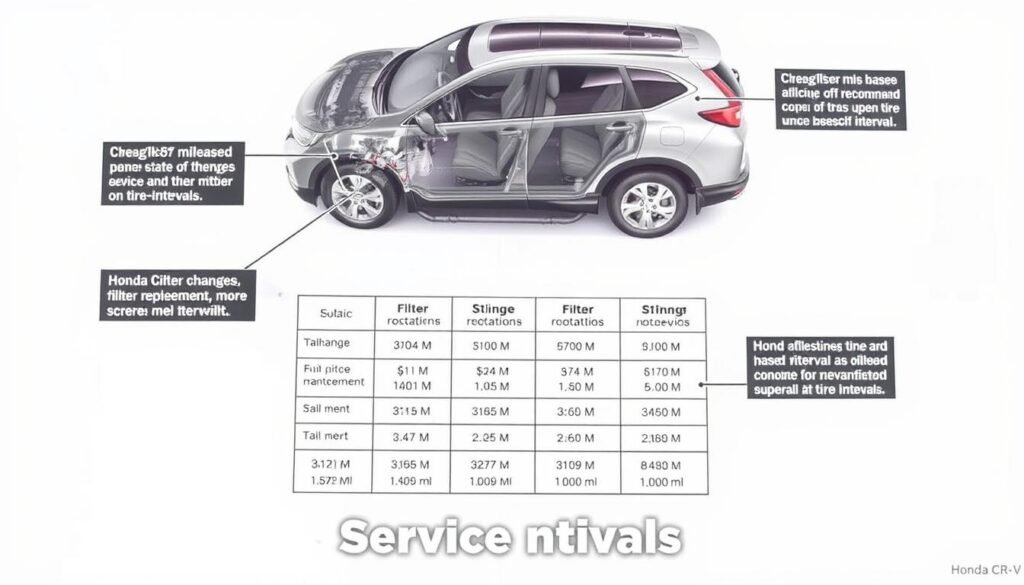
Honda CR V Maintenance Schedule Overview
It’s key to know the Honda CR-V maintenance schedule. It keeps your car reliable and performing well.
This plan tells you when your CR-V needs service based on how you drive. Knowing this means you can pick the right care plan for your car.
What’s Included in The Maintenance Schedule?
The Honda CR-V’s maintenance plan covers lots of important services. These are:
- Oil changes and filters
- Tire rotations and inspections
- Brake system checks
- Fluid level assessments
- Battery and electrical system evaluations
- Routine inspections of belts and hoses
Normal Conditions vs. Severe Conditions
Choosing the right maintenance path matters for your car’s health. Normal conditions mean mostly highway driving with little weight and fewer short rides.
For this, standard upkeep is fine. But severe conditions include lots of short trips, carrying heavy loads, or driving in harsh weather. You’ll need service more often to keep problems away.
Routine Services According To Mileage
Knowing which services your Honda CR-V needs at different mileages can help keep it running well.
This guide outlines important services recommended when you hit certain mileage markers. By staying on top of these, you can keep your car performing at its best.
7,500 To 15,000 Miles
Between 7,500 to 15,000 miles, your car will need a few key services:
- Oil change to ensure engine health.
- Tire rotation for even wear and improved longevity.
- Fluid checks, including coolant and brakes, to prevent issues.
30,000 To 60,000 Miles
As your car’s mileage goes up, it needs more care:
- Replace air filters for optimal airflow and engine efficiency.
- Brake inspection to ensure safety and performance.
- Fluid replacements, including transmission and brake fluids, for reliability.
90,000 To 120,000 Miles
When you reach higher mileages, thorough maintenance is crucial:
- Comprehensive inspection of belts and hoses for wear and tear.
- Replacement of spark plugs to enhance engine performance.
- Review of the complete system, including suspension and steering components, for any needed repairs.
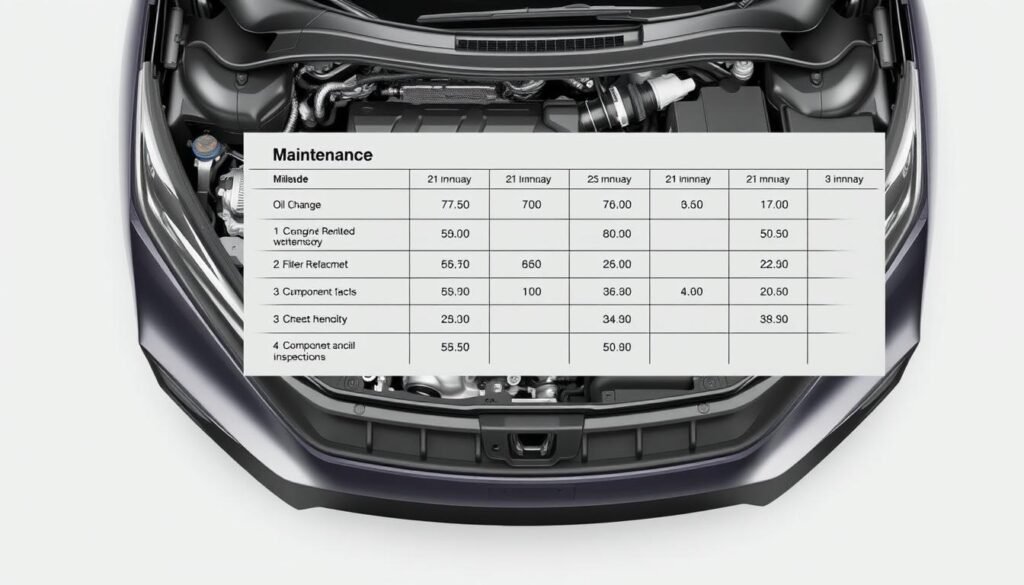
Honda CR-V Tune-Up Schedule
If you want your Honda CR-V to stay in top shape, stick to a proper maintenance plan. This includes regular tune-ups to keep your engine running well.
Most car guides say to get a tune-up every 30,000 miles. At each tune-up, experts look at and fix important parts. They change spark plugs for better starting.
They check the ignition system to make sure your car runs reliably. Also, they inspect the fuel system to prevent clogs and improve gas mileage.
Knowing when your Honda CR-V needs a tune-up is key. Look out for signs like slower acceleration, engine problems, or using more gas than usual.
Spotting these signs early means you can get help fast, so your car keeps running smoothly.
Essential Maintenance Tasks in The Schedule
Keeping your Honda CR-V in top shape is key. Regular maintenance is important for its performance and lasting power.
By focusing on necessary upkeep tasks, you’ll make sure your vehicle stays reliable and safe. Following the right honda cr v service intervals and maintenance tips is crucial.
Oil Changes and Filter Replacements
Changing the oil regularly keeps the engine running smoothly. Over time, old oil can’t protect the engine parts well, causing extra wear.
It’s important to change the oil filter with every oil change as well. This stops dirt from getting into the engine.
Based on how you drive, changing oil every 5,000 to 7,500 miles is a good idea.
Tire Maintenance
Your tires are crucial for a safe ride. It’s essential to check the tire pressure, tread depth, and make sure the wheels are aligned right.
Every 5,000 to 7,500 miles, rotate the tires. This will make them last longer. It’s a key part of honda cr v service intervals.
Brake Inspections
Having good brakes is all about safety. Regular checks of your brake pads, rotors, and fluid can catch problems early.
Try to have a thorough brake check every 15,000 miles, or as your driving habits require. This not only keeps you safe but also ensures your honda cr v brakes effectively.
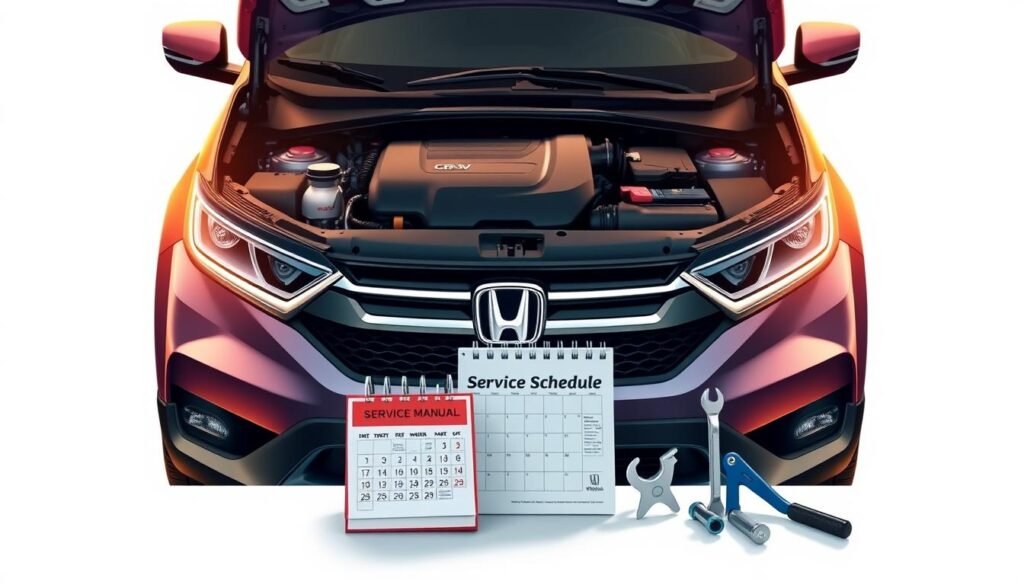
Best Practices For Honda CR-V Maintenance
To keep your Honda CR-V running well, follow some key best practices. Start with a detailed honda cr v maintenance checklist.
It helps you keep track of needed services, fluid levels, and any repairs. Make sure to check your vehicle’s fluids, like oil, coolant, and brake fluid, regularly.
It’s smart to use genuine Honda parts. These parts are made to fit your vehicle perfectly, which keeps it working well.
Pay attention to signs of wear, like strange noises or dashboard warning lights. Catching these signs early can save you both time and money by avoiding bigger problems.
Sticking to the Honda CR-V’s recommended maintenance schedule is important. By keeping up with maintenance, you can avoid breakdowns. This means your car will run smoothly for a long time.
Honda CR-V Recommended Service Timeline
It’s crucial to know the Honda CR-V recommended service timeline for your vehicle’s health and performance.
The standard maintenance schedule is a good start, but it’s smart to adjust it for your driving style and conditions.
This approach helps with the wear and tear, keeping your car at its best.
Customizing The Schedule Based on Driving Conditions
Driving in the city with lots of stops or in tough weather means you might need to tweak your maintenance schedule.
By doing more frequent checks and services, you can catch any issues early. This keeps your Honda CR-V running smoothly.
When adjusting your service timeline, think about these points:
- Driving Intensity: Short trips often can stress your engine more.
- Terrain: Driving off-road means checking your suspension and tires more.
- Climate: Hot or cold weather affects fluid levels and tires.
By considering these factors, you can make your Honda CR-V’s service timeline work better for you. This ensures your car stays reliable and safe.

| Driving Condition | Recommended Adjustment |
|---|---|
| Urban Stop-and-Go | Increase oil change frequency by 10% |
| Off-Road Use | Inspect suspension and tires every 3,000 miles |
| Extreme Climate | Check fluid levels bi-annually |
Staying on Track with The Honda CR V Maintenance Schedule
It’s important to keep up with your Honda CR-V’s maintenance schedule. It helps make sure your car stays in great shape over time.
Set reminders on your phone or use a calendar app. This way, you won’t forget when it’s time for service. Keeping a maintenance log is also a smart move.
Write down each service, including what was done and when. This makes it easy to talk about your car’s history with a technician.
- Consider utilizing dedicated digital apps designed to track vehicle maintenance.
- Regularly check in with your trusted service provider to discuss the upcoming services based on the honda cr v routine maintenance guide.
- Schedule appointments at the appropriate mileage intervals for oil changes, tire rotations, and other essential tasks.
Using these tips will keep your Honda CR-V in top shape. Sticking to the maintenance plan is key for the best performance and safety on the road.
Conclusion
Following the Honda CR-V’s maintenance schedule is key to its safety, high performance, and long life. With a structured maintenance checklist, you can spot issues early.
This keeps your Honda CR-V reliable. Regular checks and services improve your drive and prevent expensive repairs later.
The Honda CR-V maintenance checklist in this guide empowers you as an owner. It helps you know when to do things like oil changes and brake checks.
This knowledge keeps your car running well. Being proactive with this schedule lets you drive worry-free.
Your Honda CR-V is more than just a car; it’s an investment in your daily life. Taking care of it means it will perform well for years.
Use this article as your go-to for Honda CR-V maintenance. It’s an important step in protecting your car’s health.
FAQs
Q: What is the recommended Honda CR-V maintenance schedule?
A: For the Honda CR-V, it’s recommended to change the oil and rotate tires every 7,500 miles. At 15,000 miles, check the fluids. More in-depth checks like brake and fluid replacements are needed at 30,000 miles. You may need to adjust this based on how and where you drive.
Q: How often should I check the fluids in my Honda CR-V?
A: You should check your CR-V’s fluids once a month. Make sure to check the engine oil, transmission fluid, coolant, brake fluid, and windshield washer fluid. This keeps your car running smoothly and avoids problems.
Q: What distinguishes normal conditions from severe conditions in maintenance schedules?
A: Normal driving conditions mean driving regularly without much stop-and-go traffic. Severe conditions include short trips, towing, or extreme weather. Knowing how you drive helps decide the right maintenance plan.
Q: When should I schedule a tune-up for my Honda CR-V?
A: You should get a tune-up for your Honda CR-V every 30,000 miles. This will include changing spark plugs and checking the ignition and fuel systems. It makes sure your engine is working well.
Q: What are some essential maintenance tasks I should not overlook?
A: Don’t forget to regularly change the oil and filters. Also, rotate the tires, check tire pressure and threads, and inspect the brakes. These tasks are crucial for safe driving and keeping your car in good shape.
Q: How can I keep track of my Honda CR-V maintenance schedule?
A: To stay on top of maintenance, keep a log and set reminders. Use digital apps for help. Also, check in with your service provider regularly. They’ll make sure your car gets what it needs on time.
Q: Can driving habits affect my Honda CR-V maintenance needs?
A: Yes, how you drive greatly influences your car’s maintenance needs. Driving often in heavy traffic, on rough roads, or in extreme weather means you might need to update your maintenance plan. This helps avoid damage.

